How to Draw Eyes
For the portrait artist, learning how to draw eyes is of essential importance. You’ve probably heard the timeless proverb, "The eyes are the window to the soul." I couldn’t agree more. The eyes can capture each individual’s unique personality.
However, don’t neglect the importance of the other facial features. Each feature supports the other and capturing that unique supportive combination results in an accurate representation of the person.
Eyes have challenged and rewarded artists throughout history. One of the things I find most surprising about human eyes is how often they are not identical to each other. Of course there will be some cases where the eyes do seem to be a perfect match. Most of the time however, each eye will differ from the other. Sometimes that difference is slight, sometimes the difference is obvious.
I did a charcoal drawing of musician, Wynton Marsalis. For demonstration purposes, see below for a segment of that drawing.
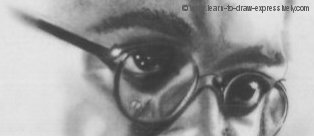
Learning how to draw eyes realistically requires that you include the subtle or the not-so-subtle differences between the two eyes. Recognizing these differences comes with close observation and drawing practice.
The beginning artist often tends to make the eyes identical (the left eye will be a mirror image of the right eye). This can lead to a drawing, which looks too perfect. It will look more like a "Ken or Barbie doll" than a real person.
Lighting also plays an important role. Lighting can make each eye appear different (as in the image above), depending on how the face catches the light.
The eyebrows cannot be overlooked. They frame the eyes. In the example above, the raised eyebrows coincide with the musician's gaze.
In reality, the "whites" of the eyes very seldom appear to be purely white. In the image above, the whites of the eyes contain a tonal range from light to dark. But there is no purely white area.
How To Draw Eyes - Enhancing Realism
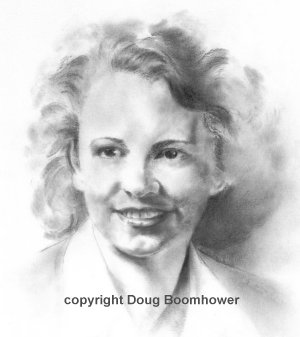
Learning how to draw eyes is an integral part of the composition.
Once again, look at the role the eyes play in this drawing of the elegant Rose Hanson. (This drawing was commissioned locally.)
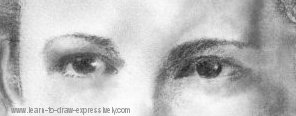
This is a pencil drawing. The highlights were done with a kneaded eraser.
Notice in the detailed enlargement that her eyes are not symmetrical, yet the subtle differences in the eyes do not detract from her beauty. Rather, they enhance the realism and character of the drawing.
Notice the luminous quality of the eye on the left. This is created by a strong highlight on the right of the eye's pupil, balanced against a very subtle highlight on the upper left of the pupil.
The centers of both eyes are dark. If you look closely, there are very subtle differences in tone within these dark areas, in order to identify the pupil. Subtleties like this play an important role in the overall effectiveness of the entire piece.
The cornea of the eye creates a natural bulge. When learning how to draw eyes, think of the upper eyelid as a blanket over that bulge. When your eye moves, the lid will move accordingly.
If you look to the left, your upper lid is also pulled to the left. If you look to the right, your upper lid is pulled to the right. The same applies if you look up or down.
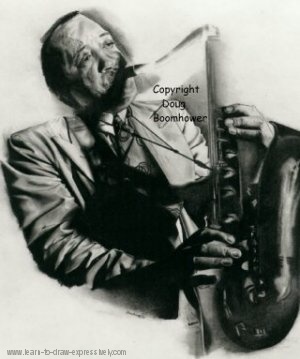
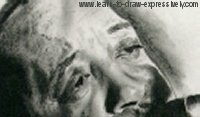
Sax player, Lester Young (a cornerstone in the history of jazz).
Notice how much of the eye is covered by the upper eyelid.
He was a very sensitive person, known for his "sad dog eyes".
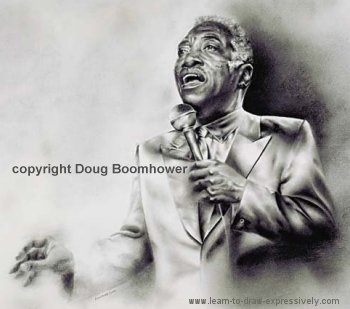
Acclaimed blues and jazz vocalist, Joe Williams.
The upper eyelids partially cover the eyes and also cast a shadow over them. That shadow varies depending on the lighting, as the two examples show.
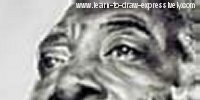
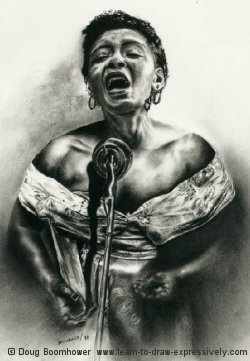
Billie Holiday, singer/composer, 1915 - 1959
In this case the upper eyelids dramatically cast shadows over the eyes.

To search my site, enter your search term in the box below, and click on the Search button. (Google ads may appear at the top of the results page ... your search results will follow.)
Return from How to Draw Eyes to
Learn To Draw Expressively Home Page




